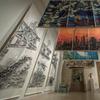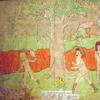Michael Rosenfeld Gallery to Represent the Estate of Hannelore Baron
- NEW YORK, New York
- /
- June 22, 2017
(New York—June 22, 2017) Michael Rosenfeld Gallery proudly announces its exclusive representation of the Estate of Hannelore Baron (1926-1987). The gallery has long been an energetic champion of Baron, including her work in such group thematic shows as Fiber & Form: The Woman’s Legacy (1996), [un]common threads (2008) and most recently, Collage: Made in America (2017). Her work is currently featured in the gallery’s summer exhibition The Time Is Now (June 17–August 4).
The gallery was eager to partner with the Baron Estate not only because of the artist’s superlative talent, but also because of the importance her artwork has had for the gallery’s founder, Michael Rosenfeld, who explains, “Since I was a teenager, I have been committed to the work of Hannelore Baron, collecting personally her box assemblages and collages. To now have the opportunity to promote and advance her legacy is an honor; it is also the fulfillment of a dream. The integrity of Baron’s work demands our attention and she deserves her spot in the canon of American art.
Hannelore Baron is celebrated for her intimate collages and assemblages that, as Michael Brenson wrote in a 1989 New York Times review, “suggest both the condition of entrapment and the possibility of release.” The compassion, anger, dissent, humor, and silence that animate her work hint at her traumatic experiences as a child in Nazi Germany. However, she was often reluctant to discuss this part of her life out of concern that it would limit interpretations of her artwork. Influenced by ancient religious texts, illuminated pages of the Koran, Persian miniatures, botanical prints, and archeological finds, Baron was concerned about the human condition, including her own — and she stated, “I am a total contradiction.”
Baron was born Hannelore Alexander in 1926, in the small German town of Dillingen, not far from the French border. She experienced a childhood fractured by violence and displacement. In 1941, the United States consulate granted the Alexander family an emigration quota number, and they were able to make their way to New York. Shortly upon her arrival, Baron enrolled in the Straubenmuller Textile High School in Manhattan. Although she did not study art formally after high school, her acquaintance with John Heliker, who taught painting at Columbia University, enabled Baron to bring her artwork to him for regular critiques. In the late 1950s, she started to incorporate collage elements into her painting, and her work was exhibited at various venues in New York. A member of the National Association of Women Artists, she began making assemblages from found wood, driftwood, and wire in 1968, when a volunteer teaching position at the Yonkers Jewish Community Center gave her access to woodworking tools. The following year, she had a solo exhibition at Ulster County Community College in Stone Ridge, New York, and she became the director of the short-lived Tyndall Creek Gallery in Riverdale. She continued to explore new ways of combining media in the 1970s; Baron developed a sculptural technique for making monotypes by shaping copper into cut-out forms (i.e. heads, figures, birds) and then inking both sides to result in mirror image printing. She also employed a “transfer drawing” technique that was popularized in the 1920s by Paul Klee. In Baron’s hands, “mixed-media” meant more than the convergence of a variety of materials and approaches in a given work. She had a singular capacity for drawing out the visual, textural, and conceptual continuities among her elements. In her work, a family resemblance is visible among wood and paper, paper and textile, wood and cloth.
Baron understood her art as a form of political expression, and this aspect became more explicit in the 1970s with several series that incorporated motifs of torn flags, war-time letters, children’s games, and anti-war protests. After several exhibitions at Kathryn Markel Gallery, Gallery Schlesinger-Boisanté (New York) arranged in 1982 an exhibition of Baron’s work in her childhood town of Dillingen. The exhibition was accompanied by a one-page artist’s statement that revealed traumatic events in her past. Baron also created a special box assemblage incorporating various German documents, including her father’s passport, which Nazi authorities had stamped with a large red “J.” Although Baron did not travel to Germany, she gave specific instructions that this construction and her statement be hung in a hall outside of the exhibition space.
In 1987, Baron, who had battled several types of cancer in her lifetime, died at the age of 61. Her early experiences of terror and persecution had continued to torment her as an adult in the form of depression and claustrophobia, but they also informed her concern for the disempowered, her mistrust of nationalism, and her fierce criticisms of war and environmental destruction. Translating her political beliefs into abstract forms, Baron created “an art of concealment and protection,” one that remains as poignant and necessary today as it was in the late twentieth century.
Over the decades, Baron’s work has been contextualized in groundbreaking museum exhibitions including The Poetic Object (San Antonio Museum of Art, San Antonio, TX, 1988); Deep Storage: Collecting, Storing, and Archiving Art (Haus der Kunst, Munich, Germany, 1997); Six Centuries of Prints and Drawings (National Gallery of Art, Washington, DC, 2004); and most recently, The Keeper (The New Museum, New York, NY, 2016). Commercial solo exhibitions have been presented consistently since 1969 with her first major museum survey in 1989 at the Solomon R. Guggenheim Museum. In 2002, Hannelore Baron: Works from 1969 to 1987 traveled to eight national venues; curated by Ingrid Schaffner for SITES (Smithsonian Institution Traveling Exhibition Services), the exhibition was accompanied by a fully-illustrated catalogue. That same year, the Art Museum at the University of Memphis presented Hannelore Baron: Fragments Shored Against Ruins.
Baron’s work is represented internationally in over thirty public collections that include the Albright-Knox Art Gallery, Buffalo, NY; Art Institute of Chicago, Chicago, IL; Brooklyn Museum, Brooklyn, NY; Solomon R. Guggenheim Museum, New York, NY; Israel Museum, Jerusalem, Israel; Los Angeles County Museum of Art, Los Angeles, CA; The Museum of Modern Art, New York, NY; Museum of Fine Arts, Boston, MA; National Gallery of Art, Washington, DC; San Francisco Museum of Modern Art, San Francisco, CA; Smithsonian American Art Museum, Washington, DC; and Whitney Museum of American Art, New York, NY.
Michael Rosenfeld Gallery is located in Chelsea, at 100 Eleventh Avenue, New York, NY, 10011. Summer gallery hours are Monday–Friday, 10:00AM–6:00PM. For visuals and additional information, please contact Marjorie Van Cura at (212) 247-0082 or mv@michaelrosenfeldart.com.
Contact:
Marjorie Van CuraMichael Rosenfeld Gallery
212-247-0082
mv@michaelrosenfeldart.com
100 Eleventh Ave @ 19th Street
New York, New York
info@michaelrosenfeldart.com
212-247-0082
http://www.michaelrosenfeldart.com






100x100_c.jpg)


![Peter Paul Rubens (Flemish, 1577–1640), After Titian (Tiziano Vecelli) (Italian [Venetian], c. 1488–1576), Rape of Europa, 1628–29. Oil on canvas, 71 7/8 x 79 3/8 in. Peter Paul Rubens (Flemish, 1577–1640), After Titian (Tiziano Vecelli) (Italian [Venetian], c. 1488–1576), Rape of Europa, 1628–29. Oil on canvas, 71 7/8 x 79 3/8 in.](/images/c/e2/2e/Jan20_Rape_of_Europa100x100_c.jpg)






